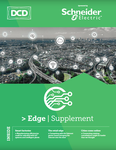The arrival of 5G and growth of Edge computing will transform the Internet, attendees were told at DCD's virtual New York conference this week.
Vinay Kanitkar, CTO of global carrier strategy at Akamai Technologies, explained how core data centers will have to prepare for a world more connected than ever.
Building the Edge
"There’s always this notion that the next generation of connectivity is going to solve everything," Kanitkar said during the Day 2 keynote for DCD>New York VIRTUAL, listing various advancements, from early cellular connectivity, all the way up to 5G.
"It never works out that way. All of the core infrastructure needs to keep up with that Edge."
But the core infrastructure of large data center hubs will struggle to keep pace: While there will be billions of last mile connections, LTE connections, and now 5G connections - all used by multiple devices - it is not feasible for all that data to converge at a few locations.
"There is a big imbalance between what the Edge can support and what the center can support," Kanitkar said. "So the middle layer is getting congested. If you try to upload a large image to iCloud or whatever, you will sympathize with me; what you can get out of these core locations is limited."
The result is that "you no longer want to put everything in the central location," Kanitkar believes. "You need to move it closer to computers and end users. We’re seeing data creation and processing happening at the Edge. Just bringing all of that data to the center, I don’t think that’s going to suffice."
While data centers will still be needed for a large number of applications, machine learning workloads, and storage, "whatever you can push outwards towards the Edge reduces the amount of complexity you have to build in the core," Kanitkar said.
This will be vital to deal with the lower latency and higher throughput 5G will bring: "The better the Edge gets, the higher your expectation gets," Kanitkar noted. "Ten years ago if you clicked on video and it worked, you would be happy. That's no longer the case, expectations have changed rapidly."
Should Edge computing prove a success, and 5G tech roll-out widely, Kanitkar forsees many of the usual industry predictions coming to pass - smart cities, augmented reality, and better video content. "We’ve spent a lot of time trying to understand what our customers see as the first wave of 5G applications," he said, but admitted that "most of the application innovation will come after the infrastructure is there, just like how it [required smartphones] to think of Uber. So the applications we are thinking of now will not be the ones we use in 10, 15 years."
These applications will define the Edge, Kanitkar argued. For self driving cars, that Edge is the processing power in the vehicle itself. For an augmented reality headset with limited computing power and battery life, that Edge is shared between the device and a relatively nearby computing cluster. "And in some cases the right places for those applications will be the big data center, where you have the compute and power to make sense of the data you have," Kanitkar said.
"What we see going forward is a divergence. I don’t think anyone believes that the need for a big data center just goes away, but at the same time we need to be able to keep up with what the network operators are seeing in terms of decentralization and 5G."






